A comfortable and stylish gardening outfit is essential for a productive day in the garden. It’s not just about looking good; it’s about feeling great while you’re nurturing your plants.
When it comes to garden fashion, there are several factors to consider. Comfort, durability, and style are key elements that can make or break your gardening experience. A good gardening attire should keep you cool in the summer and warm in the cooler months, all while withstanding the rigors of gardening work.
Key Takeaways
- Comfort is crucial for a productive gardening day.
- Durability ensures your attire withstands gardening tasks.
- Style matters for a confident gardening experience.
- Consider the climate when choosing your gardening attire.
- A good gardening outfit enhances your overall gardening experience.
Why the Right Gardening Outfit Matters
A well-chosen gardening attire can make a significant difference in your gardening experience. It’s not just about looking good; it’s about feeling comfortable and being able to work efficiently in your garden.
Comfort and Mobility Considerations
When it comes to gardening, comfort and mobility are key. Gardening clothes should allow for a full range of motion without restriction. This means choosing clothes that are not too tight or too loose, and are made from materials that breathe and move with you.
Protection from the Elements
Gardening exposes you to various elements, from the sun’s harmful rays to thorns and prickly plants. Outdoor apparel designed for gardening should provide protection against these elements. Look for clothes with built-in UPF protection to prevent sunburn and consider wearing long sleeves and pants for added protection.
Durability for Garden Tasks
A good gardening outfit should be durable enough to withstand the rigors of garden work. This includes being resistant to tears and punctures, as well as soil and stain resistance.
Resistance to Tears and Punctures
Gardening can be rough on clothes, with thorns, branches, and other hazards waiting to cause damage. Clothes made from durable, tear-resistant materials can help extend the life of your gardening outfit.
Soil and Stain Resistance
Gardening inevitably involves getting dirty. Clothes treated with soil and stain-resistant coatings can make cleaning easier and help maintain the appearance of your gardening clothes.
By considering these factors, you can choose a gardening outfit that not only makes gardening more enjoyable but also more productive.
Essential Components of the Perfect Gardening Outfit
Creating the perfect gardening outfit involves several key components that work together to ensure a productive and enjoyable gardening experience. A well-crafted gardening outfit is not just about aesthetics; it’s about functionality, comfort, and protection.
Base Layers and Tops
The base layer is crucial as it is in direct contact with the skin. Breathable materials like cotton or moisture-wicking synthetics are ideal for regulating body temperature. For tops, consider gardening shirts with built-in UPF protection to prevent sunburn. Lightweight, loose-fitting designs allow for ease of movement.
Bottoms and Pants Options
Gardening often involves kneeling, bending, and walking through various terrains, making durable and comfortable bottoms essential. Gardening pants or overalls with reinforced knee patches are highly recommended. For warmer weather, gardening shorts can be a good alternative, offering flexibility and comfort.
Footwear Requirements
Good gardening footwear is vital for protecting feet from thorns, mud, and other hazards. Waterproof boots or shoes with good grip are ideal for wet conditions, while lightweight shoes or sandals with a sturdy sole are suitable for dry weather.
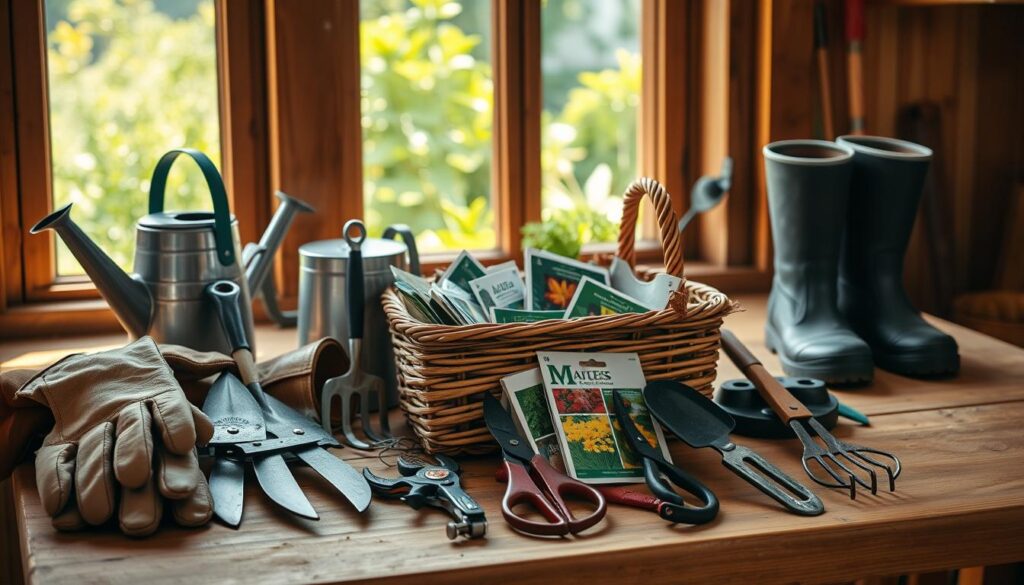
Protective Accessories
Protective accessories play a significant role in enhancing the gardening experience. They not only protect the gardener from potential hazards but also add to the overall comfort.
Hats and Sun Protection
A wide-brimmed hat is a simple yet effective way to protect the face, neck, and ears from the sun. Look for hats with a breathable design to keep cool.
Knee Pads and Support Items
Knee pads are indispensable for gardeners who spend a lot of time kneeling. They provide cushioning and support, reducing strain on the knees. Some gardening pants come with built-in knee pads, offering an integrated solution.
By incorporating these essential components into your gardening outfit, you can ensure a more enjoyable, productive, and safe gardening experience. Whether you’re a seasoned horticulturist or a casual gardener, investing in the right gardening gear and horticulture attire is well worth the effort.
Choosing the Perfect Gardening Tops
Gardening tops that are both functional and stylish are essential for any plant lover’s outfit. The right top can enhance your gardening experience by providing comfort and protection.
Breathable Materials for Hot Weather
When gardening in hot weather, it’s crucial to wear tops made from breathable materials. This helps in keeping you cool and dry.
Cotton vs. Synthetic Fabrics
Cotton is a natural, breathable fabric that absorbs moisture. Synthetic fabrics, on the other hand, are often designed with moisture-wicking technologies. Monty Don prefers cotton drill shirts for their durability and comfort.
Moisture-Wicking Technologies
Moisture-wicking fabrics draw sweat away from the skin, allowing it to evaporate quickly. This technology is particularly useful during intense gardening sessions.
Layering Options for Variable Conditions
Layering is key to adapting to changing weather conditions. It allows you to adjust your clothing to suit the temperature.
For cooler mornings and evenings, consider adding a lightweight jacket or sweater to your stylish gardening attire.
Sleeve Considerations for Sun Protection
Sleeve length is an important consideration for sun protection. Longer sleeves can protect your arms from harmful UV rays.
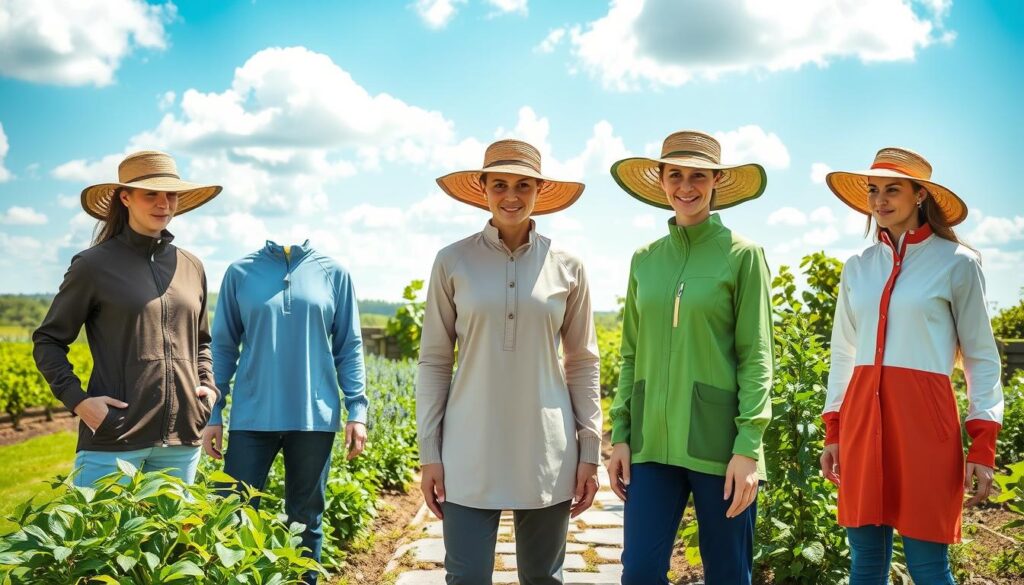
| Feature | Cotton | Synthetic |
|---|---|---|
| Breathability | High | Variable |
| Moisture-Wicking | Low | High |
| Durability | High | Variable |
Selecting Ideal Gardening Bottoms
The ideal gardening bottoms can significantly enhance your gardening experience by providing comfort and flexibility. Whether you’re tending to a vegetable garden or maintaining ornamental flower beds, the right bottoms can make a substantial difference.
Pants vs. Shorts: When to Choose Each
One of the primary decisions when selecting gardening bottoms is whether to opt for pants or shorts. Pants are generally recommended for cooler weather or for tasks that involve thorny plants or dense foliage, as they offer more protection against scratches and abrasions. On the other hand, shorts are ideal for warmer weather, providing better ventilation and comfort during hot summer days.
Features to Look for in Gardening Pants
Gardening pants are designed with specific features that enhance their functionality. Two key aspects to consider are:
Reinforced Knees and Seat
Many gardening pants come with reinforced knees and seat, areas that are prone to wear and tear due to kneeling and sitting. This feature significantly extends the lifespan of the pants.
Pocket Placement and Utility
Another important feature is the placement and utility of pockets. Well-designed gardening pants often have multiple pockets for storing tools, seeds, and other gardening essentials, keeping them within easy reach.
Practical Options for Different Seasons
The choice of gardening bottoms can also be influenced by the season. For instance, waterproof or water-resistant pants are beneficial during wet conditions, while lightweight, breathable fabrics are preferable in warmer weather. Understanding these seasonal needs can help in selecting the most appropriate gardening bottoms.
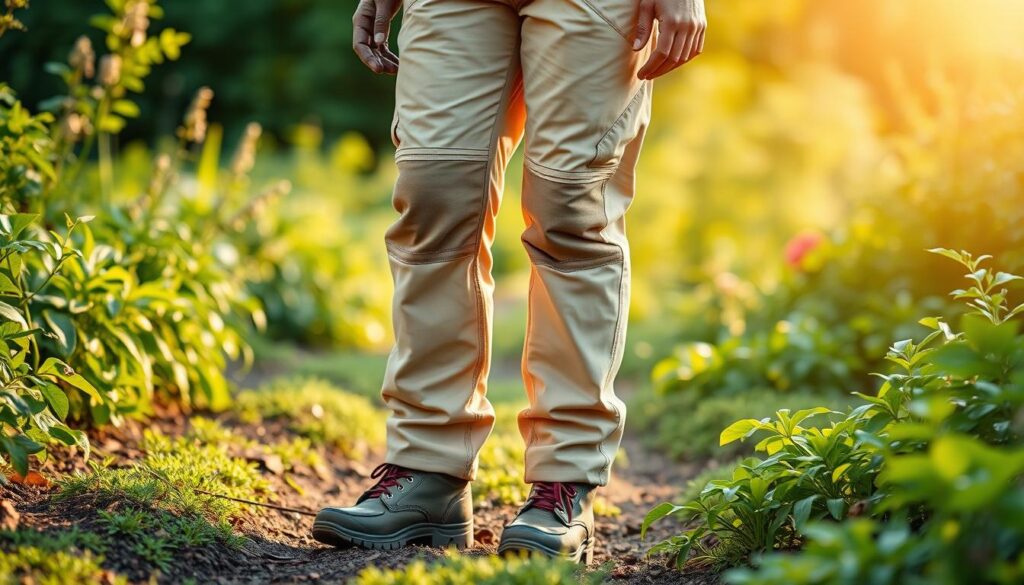
Footwear for Garden Work
Footwear plays a vital role in gardening, offering protection, comfort, and support for the gardener. The right shoes can make a significant difference in your gardening experience, whether you’re working in wet conditions or dry soil.
Garden Boots and Their Benefits
Garden boots are a popular choice among gardeners due to their protective qualities. They shield the feet from mud, water, and sharp objects, making them ideal for messy or wet gardening tasks. Merry People’s rain boots, for instance, are favored for their waterproofing and durability.
Waterproof Options for Wet Conditions
For gardening in wet conditions, waterproof footwear is essential. It keeps feet dry and comfortable, reducing the risk of discomfort or fungal infections. Look for boots with a waterproof membrane, such as Gore-Tex or similar technology, for optimal dryness.
Lightweight Alternatives for Dry Weather
In dry weather, gardeners can opt for lightweight footwear that still offers protection but with enhanced breathability. These shoes are perfect for tasks that don’t involve wet or muddy conditions, providing comfort during long hours of gardening.
Insoles and Comfort Features
Comfort is key when it comes to gardening footwear. Features like supportive insoles, cushioning, and ergonomic design can significantly enhance the gardening experience. Support for long hours of standing is particularly important, as it helps prevent fatigue and discomfort.
Support for Long Hours of Standing
For gardeners who spend long hours on their feet, footwear with excellent arch support and cushioning is crucial. This can help reduce strain on the feet and legs, making gardening more enjoyable.
Quick-Drying Materials
Footwear made from quick-drying materials is also beneficial, especially for gardeners who work in damp conditions. These materials help keep feet dry and comfortable, even when exposed to moisture.
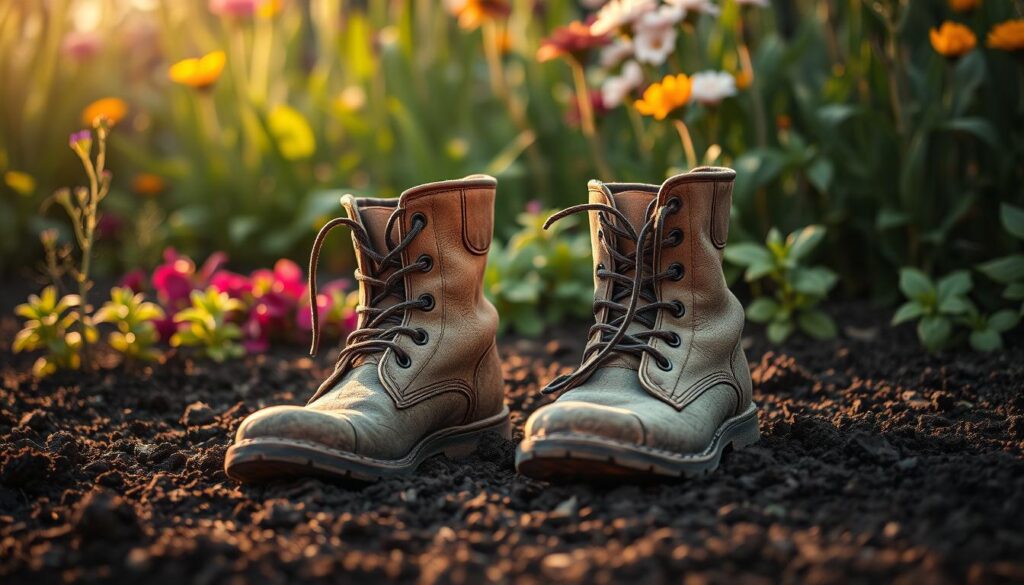
| Footwear Type | Best For | Key Features |
|---|---|---|
| Garden Boots | Wet and muddy conditions | Waterproofing, durability |
| Lightweight Shoes | Dry weather gardening | Breathability, comfort |
| Waterproof Boots | Wet conditions | Waterproof membrane, support |
Protective Gardening Gloves
Protective gardening gloves are a vital component of any gardener’s attire, providing safety and comfort during various gardening tasks. Gardening involves handling plants with thorns, prickles, and dirt, making hand protection essential.
Material Options and Their Benefits
The choice of material for gardening gloves significantly affects their performance and durability. Different materials offer unique benefits.
Leather vs. Synthetic Choices
Leather gloves, like those recommended by Monty Don for rose pruning, offer durability and protection against thorns. Synthetic materials, on the other hand, can provide flexibility and ease of cleaning.
Puncture-Resistant Technologies
Some gardening gloves incorporate puncture-resistant technologies, enhancing their protective capabilities. These gloves are particularly useful for tasks involving thorny plants or sharp objects.
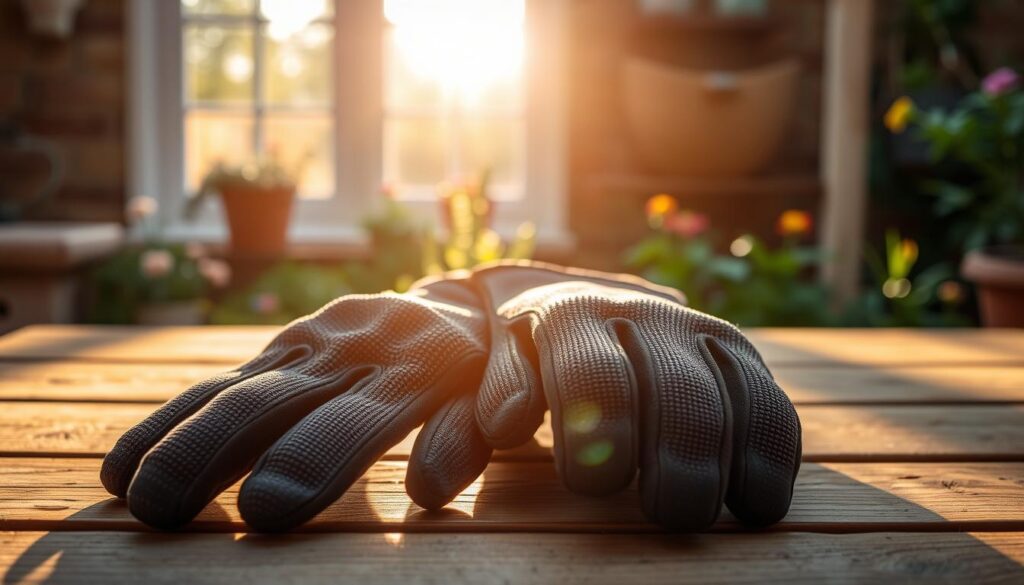
Length and Coverage Considerations
The length and coverage of gardening gloves are crucial for protecting against various gardening hazards. Longer gloves can protect forearms from scratches, while shorter gloves offer more dexterity.
Specialized Gloves for Different Tasks
Different gardening tasks require specialized gloves. For instance, thin gloves are ideal for weeding and handling delicate plants, whereas heavier, more protective gloves are better suited for pruning and handling thorny plants.
| Task | Glove Type | Material |
|---|---|---|
| Rose Pruning | Heavy-duty | Leather |
| Weeding | Lightweight | Synthetic |
| Gardening General | Versatile | Mixed Material |
By choosing the right gardening gloves for the task at hand, gardeners can ensure their hands remain protected and comfortable throughout their gardening activities.
Budget-Friendly Gardening Clothes Options
Gardening on a budget doesn’t mean sacrificing style or functionality. With a little planning, you can create a stylish gardening attire that is both functional and affordable.
When it comes to gardening clothes, there are several options to consider. You can opt for investment pieces that are durable and long-lasting or choose affordable alternatives that still offer quality and functionality.
Investment Pieces vs. Affordable Alternatives
Investment pieces are typically made from high-quality materials and are designed to last. While they may be more expensive, they can be a worthwhile investment in the long run. On the other hand, affordable alternatives can be a great option for those on a tight budget or for items that are not used frequently.
| Investment Pieces | Affordable Alternatives |
|---|---|
| High-quality materials | More affordable materials |
| Durable and long-lasting | May not be as durable |
| Typically more expensive | Budget-friendly |
Multi-Purpose Outdoor Clothing
Multi-purpose outdoor clothing can be a great option for gardening. These clothes are designed to be versatile and can be used for a variety of outdoor activities, including gardening. They are often made from breathable, water-resistant materials and can be layered for different conditions.
Secondhand and Upcycled Options
Secondhand and upcycled options are another way to create a stylish and functional gardening attire on a budget. You can find great deals on gently used gardening clothes or repurpose old clothes to create new gardening attire.
Repurposing Old Clothes for Garden Use
Repurposing old clothes is a creative way to reduce waste and create a unique gardening attire. You can turn old shirts into gardening aprons or use old pants to create gardening knee pads.
Where to Find Quality Used Garden Wear
You can find quality used garden wear at thrift stores, online marketplaces, or through local gardening groups. When shopping secondhand, make sure to inspect the clothes carefully for any damage or wear.
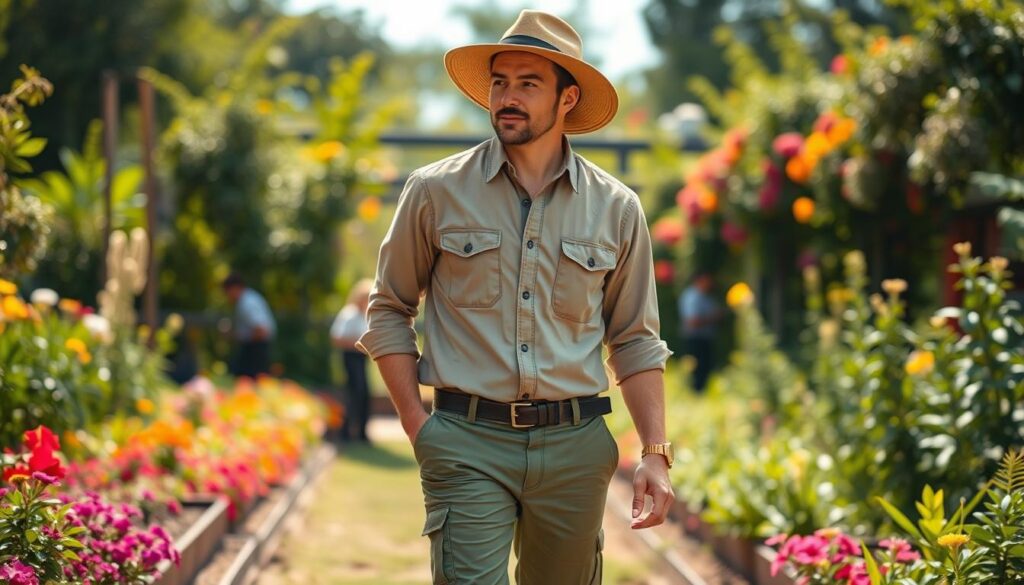
Gardening Outfit Considerations for Different Activities
Gardening activities require specific attire to ensure safety and comfort. Different gardening tasks demand different types of clothing to ensure that gardeners can work efficiently and safely.
Vegetable Garden Attire
When working in a vegetable garden, it’s essential to wear clothing that allows for ease of movement and protects against dirt and potential thorns. Consider wearing breathable tops and sturdy pants that can withstand the rigors of gardening tasks such as weeding and harvesting.
Flower Bed and Ornamental Garden Clothing
For flower beds and ornamental gardens, the attire can be slightly more versatile, allowing for a mix of functionality and style. Gardeners can opt for lightweight, breathable clothing that keeps them cool while working among flowers.
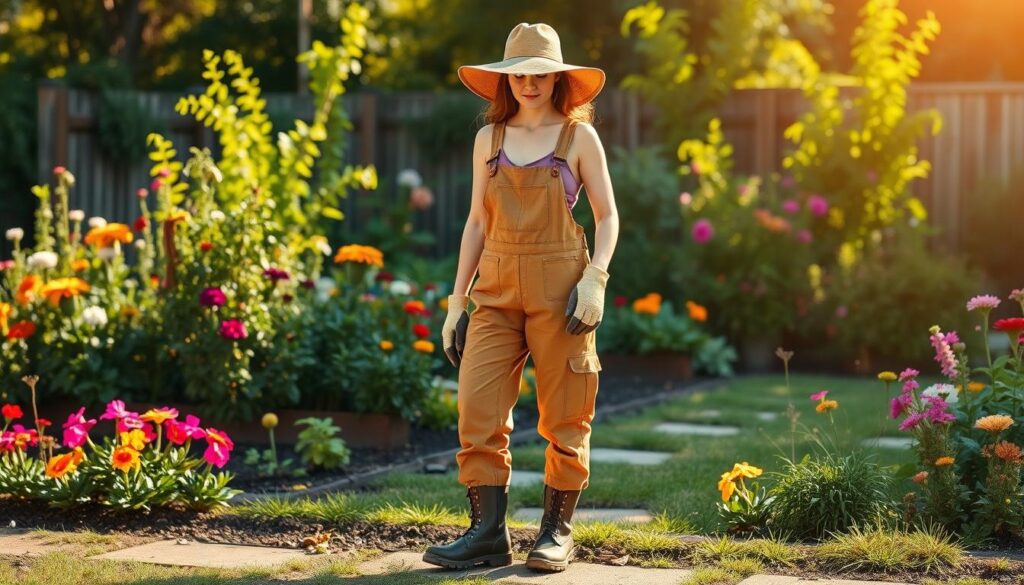
Pruning and Tree Work Protective Wear
Pruning and tree work require more protective gear, including long-sleeved shirts, gloves, and protective eyewear. This protective wear helps prevent injuries from thorns, branches, and other hazards.
Seasonal Gardening Clothing Needs
Gardening clothing needs vary significantly with the seasons. Understanding these needs is crucial for maintaining comfort and productivity throughout the year.
Spring Gardening Attire
In the spring, gardeners can benefit from layered clothing that can be adjusted according to the changing weather conditions. Lightweight, breathable fabrics are ideal for spring gardening.
Summer Heat Protection Strategies
During the summer, the focus should be on heat protection and breathability. Light-colored, loose-fitting clothing and hats can help protect against the sun.
Fall Layering Techniques
In the fall, layering becomes essential as the weather can be quite unpredictable. Gardeners should opt for versatile, layered clothing that can be adjusted as needed.
Winter Gardening Considerations
For winter gardening, warm, waterproof clothing is essential. Gardeners should invest in insulated, waterproof jackets and warm gloves to stay protected against cold and wet conditions.
Caring for Your Gardening Clothes
Maintaining your gardening clothes is crucial for their longevity and performance. Proper care ensures that your outdoor apparel remains functional, comfortable, and ready for the next gardening task.
Cleaning Heavily Soiled Items
Gardening clothes often get heavily soiled with dirt, grime, and plant sap. Pre-treat stains before washing to increase the chances of removal. Use a gentle detergent that is designed for outdoor apparel to preserve the fabric’s water-repellent coatings and breathability.
Extending the Life of Garden Wear
Regular maintenance can significantly extend the life of your gardening clothes. Check for and repair any tears or worn-out areas. Re-waterproofing your gear periodically can also help maintain its performance.
Storage Solutions Between Uses
Proper storage is key to keeping your gardening clothes in good condition.
- Hang items that are best kept on a hanger to prevent creasing.
- Fold and store items in a dry, well-ventilated area.
Drying Techniques for Wet Gear
For wet gear, air drying is recommended. Avoid direct sunlight as it can cause fading and degradation of fabric treatments.
Seasonal Storage Considerations
At the end of each season, clean your gardening clothes thoroughly before storing them. Consider using breathable storage bags to keep them fresh.
| Care Method | Benefit |
|---|---|
| Pre-treating stains | Effective stain removal |
| Regular maintenance | Extends clothing life |
| Proper storage | Prevents damage and creasing |
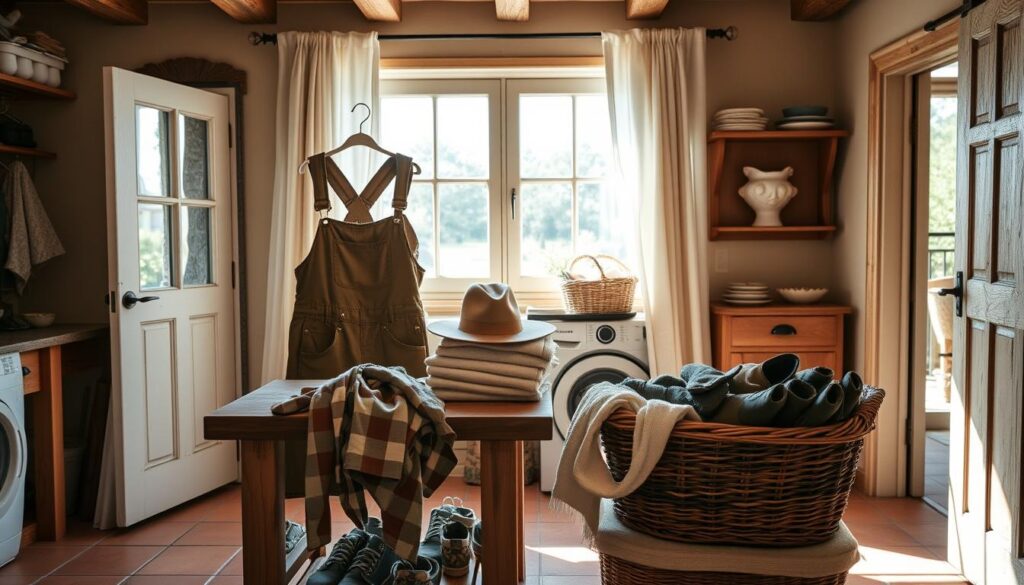
Conclusion: Enjoying Gardening in Comfort and Style
Investing in the right gardening gear is essential for a productive and enjoyable gardening experience. A well-chosen horticulture attire not only enhances comfort but also ensures protection from the elements, allowing gardeners to focus on their tasks without distraction.
By considering factors such as comfort, mobility, and durability, gardeners can create an ideal gardening outfit. This includes selecting appropriate tops, bottoms, footwear, and protective accessories that suit their specific gardening needs.
Whether you are a seasoned gardener or just starting out, having the right gardening gear can make a significant difference. It is about finding a balance between functionality and style, ensuring that your horticulture attire is both practical and comfortable.
By applying the tips and guidelines outlined in this article, gardeners can enjoy their gardening activities while looking great in their chosen attire.



